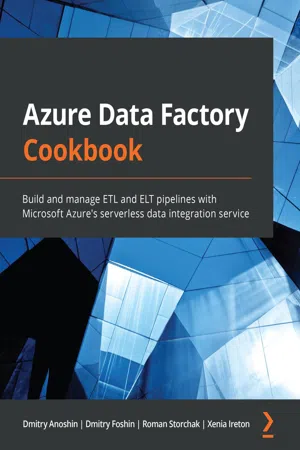
Azure Data Factory Cookbook
Build and manage ETL and ELT pipelines with Microsoft Azure's serverless data integration service
- 382 pages
- English
- ePUB (mobile friendly)
- Available on iOS & Android
Azure Data Factory Cookbook
Build and manage ETL and ELT pipelines with Microsoft Azure's serverless data integration service
About this book
Solve real-world data problems and create data-driven workflows for easy data movement and processing at scale with Azure Data Factory
Key Features
- Learn how to load and transform data from various sources, both on-premises and on cloud
- Use Azure Data Factory's visual environment to build and manage hybrid ETL pipelines
- Discover how to prepare, transform, process, and enrich data to generate key insights
Book Description
Azure Data Factory (ADF) is a modern data integration tool available on Microsoft Azure. This Azure Data Factory Cookbook helps you get up and running by showing you how to create and execute your first job in ADF. You'll learn how to branch and chain activities, create custom activities, and schedule pipelines. This book will help you to discover the benefits of cloud data warehousing, Azure Synapse Analytics, and Azure Data Lake Gen2 Storage, which are frequently used for big data analytics. With practical recipes, you'll learn how to actively engage with analytical tools from Azure Data Services and leverage your on-premise infrastructure with cloud-native tools to get relevant business insights. As you advance, you'll be able to integrate the most commonly used Azure Services into ADF and understand how Azure services can be useful in designing ETL pipelines. The book will take you through the common errors that you may encounter while working with ADF and show you how to use the Azure portal to monitor pipelines. You'll also understand error messages and resolve problems in connectors and data flows with the debugging capabilities of ADF.
By the end of this book, you'll be able to use ADF as the main ETL and orchestration tool for your data warehouse or data platform projects.
What you will learn
- Create an orchestration and transformation job in ADF
- Develop, execute, and monitor data flows using Azure Synapse
- Create big data pipelines using Azure Data Lake and ADF
- Build a machine learning app with Apache Spark and ADF
- Migrate on-premises SSIS jobs to ADF
- Integrate ADF with commonly used Azure services such as Azure ML, Azure Logic Apps, and Azure Functions
- Run big data compute jobs within HDInsight and Azure Databricks
- Copy data from AWS S3 and Google Cloud Storage to Azure Storage using ADF's built-in connectors
Who this book is for
This book is for ETL developers, data warehouse and ETL architects, software professionals, and anyone who wants to learn about the common and not-so-common challenges faced while developing traditional and hybrid ETL solutions using Microsoft's Azure Data Factory. You'll also find this book useful if you are looking for recipes to improve or enhance your existing ETL pipelines. Basic knowledge of data warehousing is expected.
Frequently asked questions
- Essential is ideal for learners and professionals who enjoy exploring a wide range of subjects. Access the Essential Library with 800,000+ trusted titles and best-sellers across business, personal growth, and the humanities. Includes unlimited reading time and Standard Read Aloud voice.
- Complete: Perfect for advanced learners and researchers needing full, unrestricted access. Unlock 1.4M+ books across hundreds of subjects, including academic and specialized titles. The Complete Plan also includes advanced features like Premium Read Aloud and Research Assistant.
Please note we cannot support devices running on iOS 13 and Android 7 or earlier. Learn more about using the app.
Information
Chapter 1: Getting Started with ADF
- Introduction to the Azure data platform
- Creating and executing our first job in ADF
- Creating an ADF pipeline by using the Copy Data tool
- Create an ADF pipeline using Python
- Creating a data factory using PowerShell
- Using templates to create ADF pipelines
Introduction to the Azure data platform


Getting ready
How to do it...
- Click Start Free.
- You can sign in to your existing Microsoft account or create a new one. Let's create one as an example.
- Enter an email address in the format [email protected] and click Next.
- Enter a password of your choice.
- Verify your email by entering the code, and click Next.
- Fill in the information for your profile (Country, Name, and so on). It will also require your credit card information.
- After you have finished the account creation, it will bring you to the Microsoft Azure portal, as shown in the following screenshot:
 Figure 1.2 – Azure portal
Figure 1.2 – Azure portal - Now, we can explore the Azure portal and find Azure data services. Let's find Azure Synapse Analytics. In the search bar, enter Azure Synapse Analytics and choose Azure Synapse Analytics (formerly SQL DW). It will open the Synapse control panel, as shown in the following screenshot:

How it works...
- 12 months of free access to po...
Table of contents
- Azure Data Factory Cookbook
- Why subscribe?
- Preface
- Chapter 1: Getting Started with ADF
- Chapter 2: Orchestration and Control Flow
- Chapter 3: Setting Up a Cloud Data Warehouse
- Chapter 4: Working with Azure Data Lake
- Chapter 5: Working with Big Data – HDInsight and Databricks
- Chapter 6: Integration with MS SSIS
- Chapter 7: Data Migration – Azure Data Factory and Other Cloud Services
- Chapter 8: Working with Azure Services Integration
- Chapter 9: Managing Deployment Processes with Azure DevOps
- Chapter 10: Monitoring and Troubleshooting Data Pipelines
- Other Books You May Enjoy